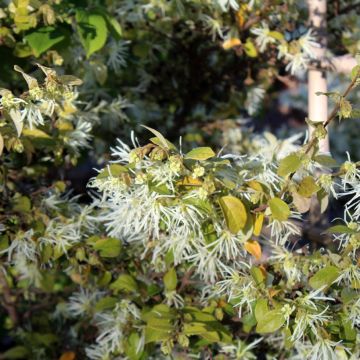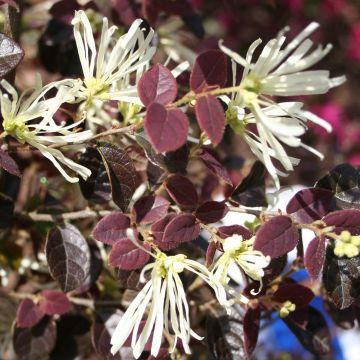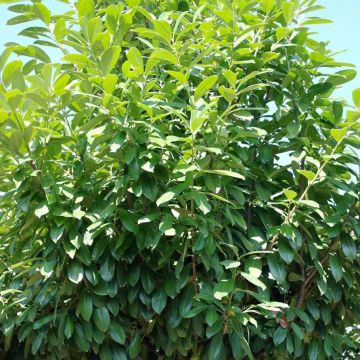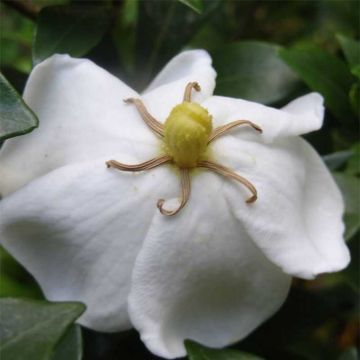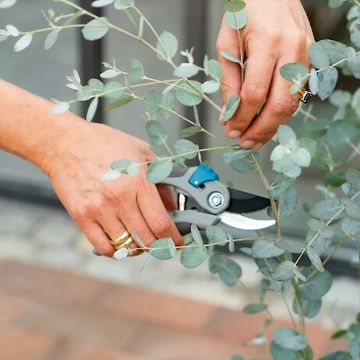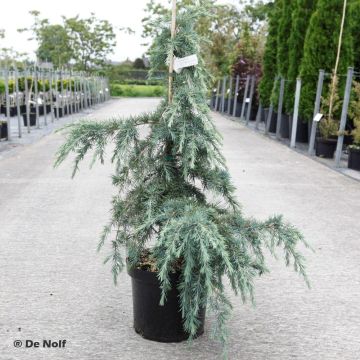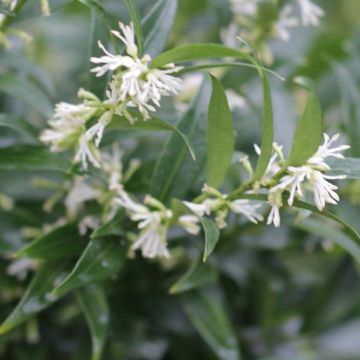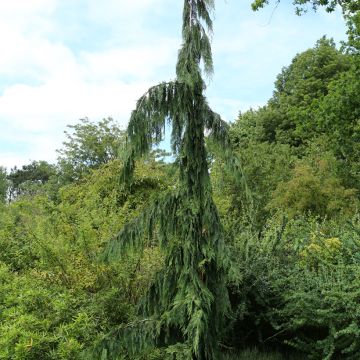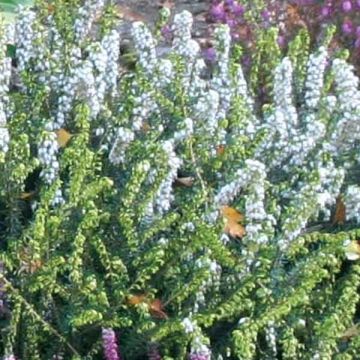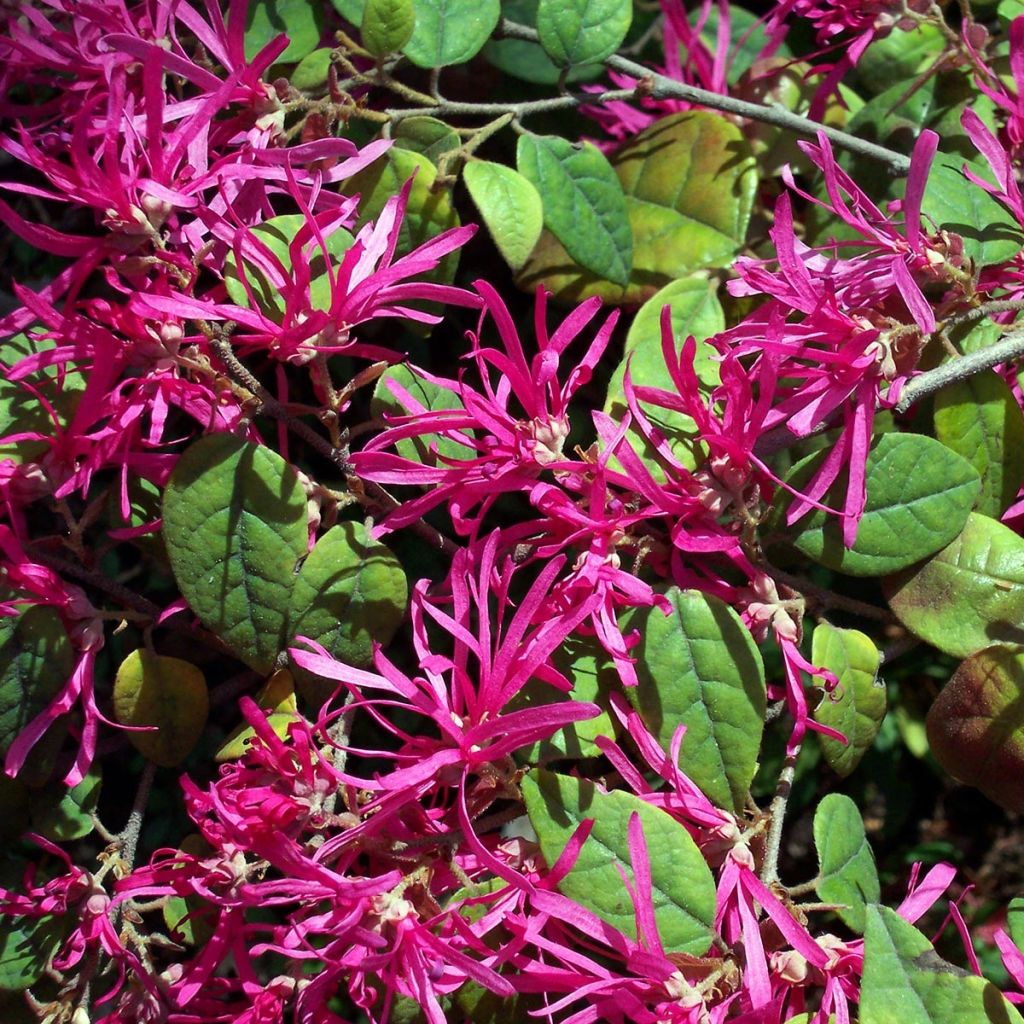

Loropetalum chinense Ming Dynasty - Chinese Witch Hazel
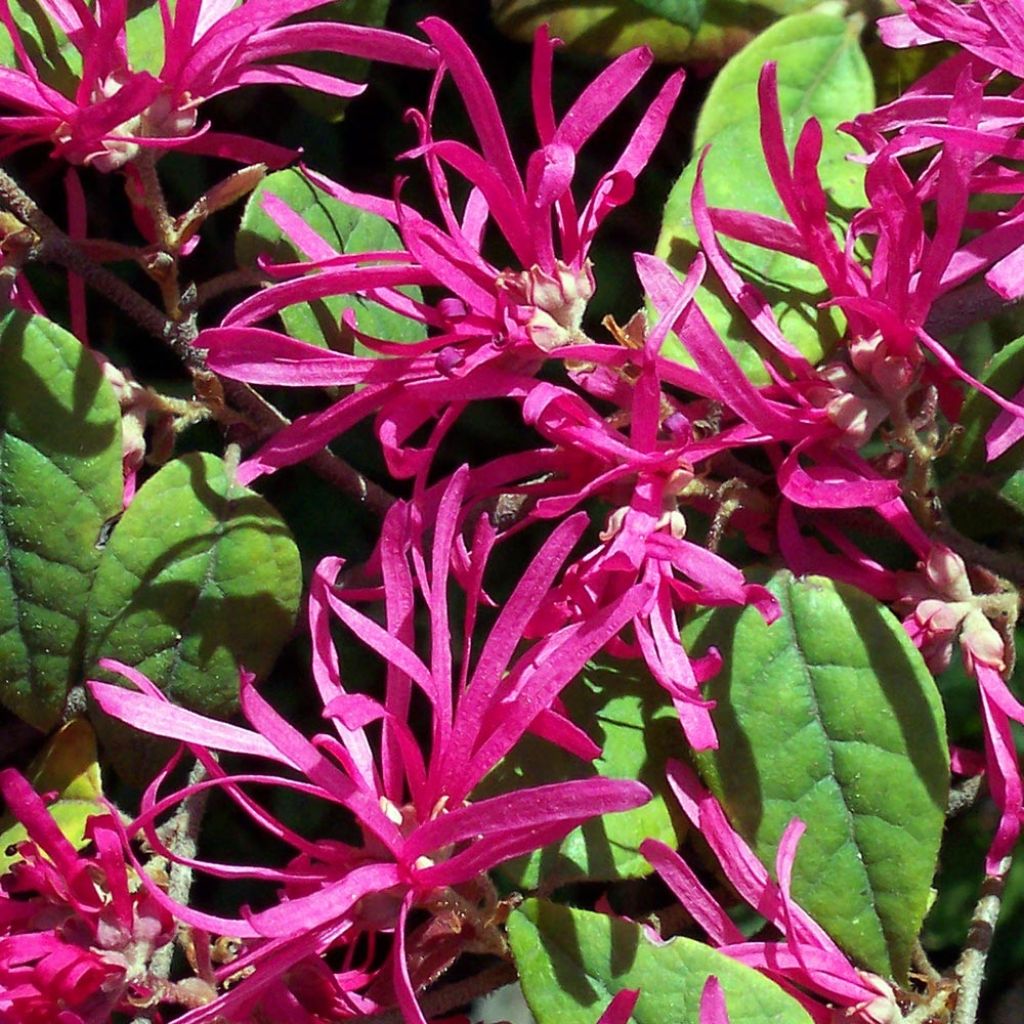

Loropetalum chinense Ming Dynasty - Chinese Witch Hazel
Loropetalum chinense Ming Dynasty - Chinese Witch Hazel
Loropetalum chinense Ming Dynasty
Chinese Witch Hazel, Chinese Fringe Flower
Why not try an alternative variety in stock?
View all →This plant carries a 24 months recovery warranty
More information
We guarantee the quality of our plants for a full growing cycle, and will replace at our expense any plant that fails to recover under normal climatic and planting conditions.
From €5.90 for pickup delivery and €6.90 for home delivery
Express home delivery from €8.90.
Does this plant fit my garden?
Set up your Plantfit profile →
Description
Loropetalum chinense 'Ming Dynasty' is a Chinese cultivar that stands out with its young foliage in very warm colours, unfurling from purple to coppery orange, passing through bronze pink. The foliage is enhanced by the vibrant colouring of its early flowering. It forms a compact bush, with a more rounded habit than other loropetalums, with spreading lateral branches and small persistent ovate, gracefully pendulous leaves, which turn dark green at maturity. From March to May, it bears numerous intense pink flowers with finely cut petals and a light fragrance, very similar to the flowers of its cousin the Witch Hazel. It sometimes flowers again during mild autumn spells. Requiring no pruning, it is a versatile shrub that can be planted as a flowering free hedge, in a semi-shaded bed, or in a pot on a terrace. Plant it in a sheltered position, under a non-burning exposure in cool, neutral to acidic, rich, and well-drained soil. In regions with mild winters, plant it in a pot to be stored in a bright, frost-free room during winter.
Loropetalum chinense, or Chinese Fringe Flower, is a shrub of the Hamamelidaceae family, as evidenced by its flowers with 4 long ribbon-like petals that resemble those of Witch Hazels. It is native to the forests of the Himalayas in China and in the northern and eastern regions of India, where it grows up to 1200 m (3937 ft) in altitude.
'Ming Dynasty' is a dwarf cultivar of Chinese Fringe Flower, with a spreading habit that turns into a red, purple, and pink fireworks display in late winter! It reaches a height and spread of about 2 m (6.6 ft) at maturity. It develops evergreen foliage. The leaves, entire and ovate in shape, measuring 2 cm to 5 cm (0.8 in to 2 in) in length, are purple to coppery orange, passing through bronze pink when they first emerge, then they turn a dark green shade. The abundant, honey-scented, and nectar-rich flowering occurs from March to May, earlier or later depending on the climate. It lasts about 2 weeks and repeats several times in this variety, even in summer or late summer, in a more sporadic manner. The flowers are grouped in 3 to 6 at the axils of the leaves, along the branches. They consist of 4 slightly twisted, intensely pink, finely cut petals and have a slight fragrance.
Loropetalums are in fashion; beautifully coloured, well-suited for container gardening, and not too bulky, they appeal to urban gardeners. They stand out in spring scenes, beautifully coloured when the garden is still sparsely blooming. Their honey-scented flowers are also a good source of nectar for bees early in the season. Once well established, they are relatively hardy, but young plants can suffer from temperatures as low as -6° C to 7° C (21.2° F to 19.4° F), so they will need protection from severe frost. You can grow them in pots in cold regions, using a non-calcareous but fertile potting soil, and store them during winter. They can be used in a free hedge or within a bed of acid-loving shrubs with staggered flowering: camellias, heaths, witch hazels, azaleas and rhododendrons, andromedas, and hydrangeas, for example.
Report an error about the product description
Loropetalum chinense Ming Dynasty - Chinese Witch Hazel in pictures
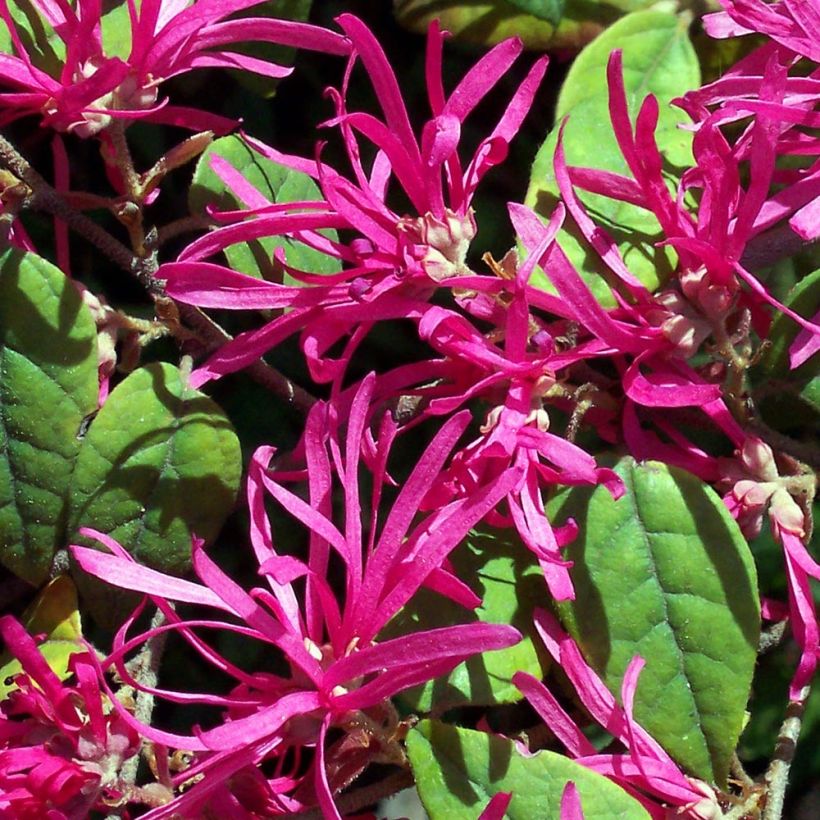

Plant habit
Flowering
Foliage
Botanical data
Loropetalum
chinense
Ming Dynasty
Hamamelidaceae
Chinese Witch Hazel, Chinese Fringe Flower
Cultivar or hybrid
Other Loropetalum
Planting and care
Plant in a sunny position that is not scorching or in partial shade (especially in hot climates), in well-drained but moist soil. It requires fertile, light, slightly acidic or even slightly alkaline soil. However, Loropetalum chinense is robust and relatively tolerant of soil conditions. It can tolerate slightly alkaline soils and is fairly drought-tolerant once well-established in deep soil, with its base shaded by large perennials or small bushes. It does not tolerate excessive water, which can cause its roots, curiously coloured in red, to rot. Therefore, good drainage is necessary: about 20 cm (7.9 in) of coarse sand, clay pellets, non-calcareous gravel, or pumice should be placed at the bottom of the planting hole. Add compost to the garden soil, and possibly a little sand to lighten it. This bushy shrub reaches a size equivalent to its height, approximately 1.75 m (5.7 ft) at maturity, so make sure to provide enough space during planting. If planted in a pot, choose a large container with a carefully drained bottom using gravel or broken pottery shards. Watering should preferably be done with slightly alkaline water or rainwater.
Diseases and pests: This bush is sensitive to root rot in poorly drained soil. It can also be attacked by olive gall, which can sometimes be fatal.
It is mainly propagated by cuttings taken from the ends of the branches in late summer.
Planting period
Intended location
Care
This item has not been reviewed yet - be the first to leave a review about it.
Evergreen shrubs
Haven't found what you were looking for?
Hardiness is the lowest winter temperature a plant can endure without suffering serious damage or even dying. However, hardiness is affected by location (a sheltered area, such as a patio), protection (winter cover) and soil type (hardiness is improved by well-drained soil).

Photo Sharing Terms & Conditions
In order to encourage gardeners to interact and share their experiences, Promesse de fleurs offers various media enabling content to be uploaded onto its Site - in particular via the ‘Photo sharing’ module.
The User agrees to refrain from:
- Posting any content that is illegal, prejudicial, insulting, racist, inciteful to hatred, revisionist, contrary to public decency, that infringes on privacy or on the privacy rights of third parties, in particular the publicity rights of persons and goods, intellectual property rights, or the right to privacy.
- Submitting content on behalf of a third party;
- Impersonate the identity of a third party and/or publish any personal information about a third party;
In general, the User undertakes to refrain from any unethical behaviour.
All Content (in particular text, comments, files, images, photos, videos, creative works, etc.), which may be subject to property or intellectual property rights, image or other private rights, shall remain the property of the User, subject to the limited rights granted by the terms of the licence granted by Promesse de fleurs as stated below. Users are at liberty to publish or not to publish such Content on the Site, notably via the ‘Photo Sharing’ facility, and accept that this Content shall be made public and freely accessible, notably on the Internet.
Users further acknowledge, undertake to have ,and guarantee that they hold all necessary rights and permissions to publish such material on the Site, in particular with regard to the legislation in force pertaining to any privacy, property, intellectual property, image, or contractual rights, or rights of any other nature. By publishing such Content on the Site, Users acknowledge accepting full liability as publishers of the Content within the meaning of the law, and grant Promesse de fleurs, free of charge, an inclusive, worldwide licence for the said Content for the entire duration of its publication, including all reproduction, representation, up/downloading, displaying, performing, transmission, and storage rights.
Users also grant permission for their name to be linked to the Content and accept that this link may not always be made available.
By engaging in posting material, Users consent to their Content becoming automatically accessible on the Internet, in particular on other sites and/or blogs and/or web pages of the Promesse de fleurs site, including in particular social pages and the Promesse de fleurs catalogue.
Users may secure the removal of entrusted content free of charge by issuing a simple request via our contact form.
The flowering period indicated on our website applies to countries and regions located in USDA zone 8 (France, the United Kingdom, Ireland, the Netherlands, etc.)
It will vary according to where you live:
- In zones 9 to 10 (Italy, Spain, Greece, etc.), flowering will occur about 2 to 4 weeks earlier.
- In zones 6 to 7 (Germany, Poland, Slovenia, and lower mountainous regions), flowering will be delayed by 2 to 3 weeks.
- In zone 5 (Central Europe, Scandinavia), blooming will be delayed by 3 to 5 weeks.
In temperate climates, pruning of spring-flowering shrubs (forsythia, spireas, etc.) should be done just after flowering.
Pruning of summer-flowering shrubs (Indian Lilac, Perovskia, etc.) can be done in winter or spring.
In cold regions as well as with frost-sensitive plants, avoid pruning too early when severe frosts may still occur.
The planting period indicated on our website applies to countries and regions located in USDA zone 8 (France, United Kingdom, Ireland, Netherlands).
It will vary according to where you live:
- In Mediterranean zones (Marseille, Madrid, Milan, etc.), autumn and winter are the best planting periods.
- In continental zones (Strasbourg, Munich, Vienna, etc.), delay planting by 2 to 3 weeks in spring and bring it forward by 2 to 4 weeks in autumn.
- In mountainous regions (the Alps, Pyrenees, Carpathians, etc.), it is best to plant in late spring (May-June) or late summer (August-September).
The harvesting period indicated on our website applies to countries and regions in USDA zone 8 (France, England, Ireland, the Netherlands).
In colder areas (Scandinavia, Poland, Austria...) fruit and vegetable harvests are likely to be delayed by 3-4 weeks.
In warmer areas (Italy, Spain, Greece, etc.), harvesting will probably take place earlier, depending on weather conditions.
The sowing periods indicated on our website apply to countries and regions within USDA Zone 8 (France, UK, Ireland, Netherlands).
In colder areas (Scandinavia, Poland, Austria...), delay any outdoor sowing by 3-4 weeks, or sow under glass.
In warmer climes (Italy, Spain, Greece, etc.), bring outdoor sowing forward by a few weeks.





































